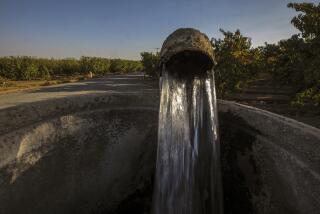Facing Up to Drought
- Share via
Back in January, Texas Gov. Mark White declared that 1985 was the critical year of decision for Texans. They would have to decide soon on a program of water development or the Lone Star state would face the prospect of economic stagnation in coming years as dwindling water supplies hindered prospects for new economic development. Further, White said, the plan would have to be a practical one that could be achieved without outside financial help--i.e., the federal Treasury. And, he added, “We must leave behind the costly pipe dreams of massive water importation--the grandiose schemes to transport all the water we will ever need from the Mississippi River.”
It was a tall order. Statewide water development plans had almost routinely been defeated by Texas voters in the past. There was growing animosity and suspicion between east and west Texas. The east feared that the west would steal its water to grow cotton and other crops. Such a scenario should sound familiar to anyone acquainted with California water problems.
Today Texas has a comprehensive $1.4-billion water development program, adopted overwhelmingly at the polls last Tuesday. A subject of bitter dispute and compromise in the Legislature this year, it is not perfect. Some environmental groups, for instance, are not wholly satisfied with the protection offered for Texas bays and estuaries. New groundwater controls are not nearly as stringent as those now in force in Arizona. But it is a major step forward, considering the structure that Texas had--with declining groundwater supplies in the Ogallala aquifer and dozens of cities imposing water restrictions to cope with drought conditions.
The keystone of the plan is a system of revenue-bond financing of local and regional water development projects and wastewater treatment facilities. Most applicants for state aid will be required to adopt water conservation programs that may include restrictions on discretionary water use, low-use plumbing standards, universal water metering and imposition of water rate structures to encourage prudent use. A companion measure authorizes a pilot project for agricultural water conservation. If successful, the new legislation authorizes a $200-million bond program to provide loans for installation of water-saving irrigation systems.
Other features provide special protection for bays and estuaries, including the dedication of some water from new programs for in-stream use to protect the wetlands and wildlife and waterfowl habitat. The package also allows the state to designate critical groundwater areas and order elections for the creation of underground water management districts.
Is there a lesson for California here? Not necessarily on a specific basis. California is California, and Texas is Texas. But a bipartisan group led by White, Lt. Gov. Bill Hobby and others has demonstrated that progress can be made toward solving seemingly intractable regional water problems and differences if the political will and leadership are present.
More to Read
Sign up for Essential California
The most important California stories and recommendations in your inbox every morning.
You may occasionally receive promotional content from the Los Angeles Times.













